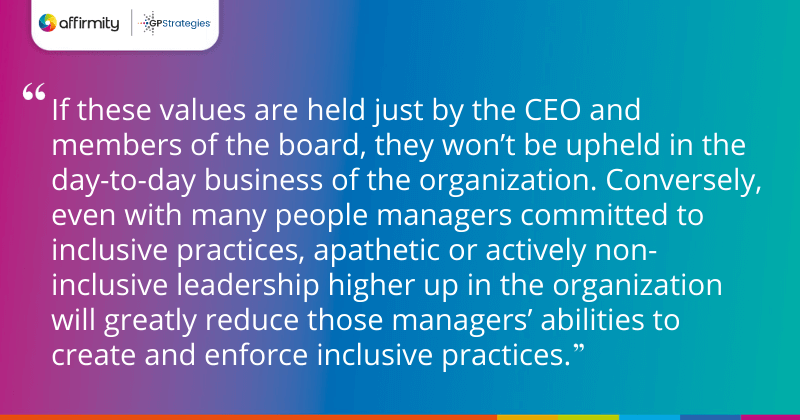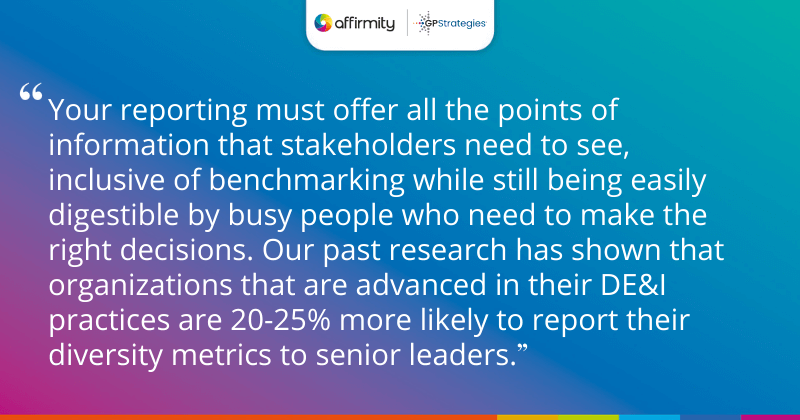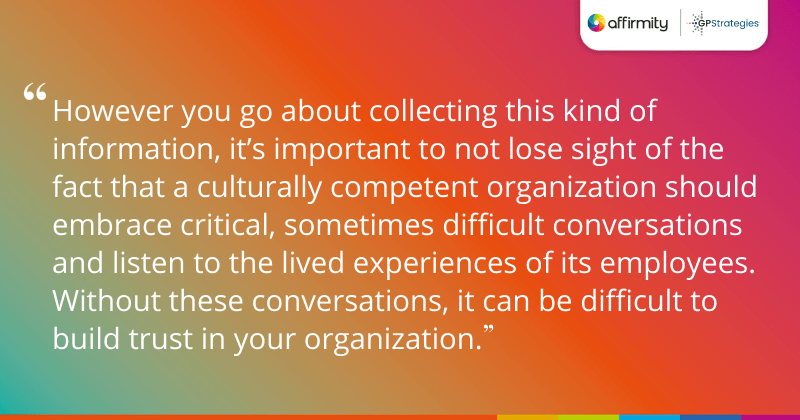The perfect DE&I strategy doesn’t happen overnight. While the best strategies account for the needs of an organization’s culture and people, there are well-defined areas that need your attention. We believe there are four key strategies that are essential to DE&I success—here’s what you should know to get started on each of them.
If we were tasked to boil the complexities of DE&I success down to just four basic ingredients, we would pick the following key strategies:
- Leading inclusively
- Knowing your diversity numbers and measuring progress
- Incorporating equity
- Cultivating a culturally-aware climate
In this article, we’ll discuss what is meant by each, the kind of work they involve, and key issues your organization may have to contend with.
1) Leading Inclusively

When we talk about inclusive leadership, it’s important to recognize that the strategic agenda of any organization is ultimately the responsibility of leadership at every level, top to bottom. Authentic leaders set a goal to deeply embed inclusion not only as a personal leadership skill, but also more broadly throughout their organization. This is because true inclusivity cannot be achieved by individuals in isolation. At best, a lone inclusive leader without support and resources can only establish a safe point of contact in a hostile environment.
This isn’t sustainable in the long term.
Despite this, inclusive leaders still hold the collective power to create change in their organization. They can set the direction and encourage a collaborative environment that promotes belonging and respect.
The qualities we believe you should look for and develop in your C-suite should be sought at every level of management. Particularly, your leaders must be intentional in their focus on promoting transparency in the organization from a structural viewpoint. They’re the ones who can provide access to processes and procedures to achieve this, and they must be motivated by the idea of doing so. Furthermore, all leaders must be committed to advancing accountability through incorporating behavioral viewpoints that encourage an open and growth-oriented mindset in the organization.
If these values are held just by the CEO and members of the board, they won’t be upheld in the day-to-day business of the organization. Conversely, even with many people managers committed to inclusive practices, apathetic or actively non-inclusive leadership higher up in the organization will greatly reduce those managers’ abilities to create and enforce inclusive practices.
FURTHER INSIGHTS FROM THE BLOG | ‘5 Challenges and High-Performance DE&I Tactics in the 2022 Future of Diversity, Equity, and Inclusion Report’
2) Knowing Your Diversity Numbers and Measuring Progress
Data from performance reviews and employee surveys helps organizations build the business case for incorporating DE&I throughout. It’s also necessary for enabling ever-essential accountability. Transparency and trust also start with the collection of this data.
There’s no doubt that data should be collected and measured. But organizations need to be strategic about the data they collect and how to work with it once they have their hands on it. Broadly speaking, we recommend that data be collected and reported on at multiple levels of the organization. Furthermore, it should capture the intersectional identities of your workforce, and not just high-level groups such as women or people of color.
Critically, your measurement also needs to be tied to a wider context. Benchmarking provides the guideposts you need and can help you make sure you’re on the right track with respect to all aspects of your talent lifecycle—hires, promotions, and separations. Used to reveal gaps and areas of opportunity, benchmarking can help you rethink your hiring and promotion process to keep you competitive, and to sustain your own progress.
How you report on this data is the next challenge: your reporting must offer all the points of information that stakeholders need to see, inclusive of benchmarking while still being easily digestible by busy people who need to make the right decisions. Our past research has shown that organizations that are advanced in their DE&I practices are 20-25% more likely to report their diversity metrics to senior leaders.
MORE ON METRICS | ‘Your Diversity Metrics: How to Break Down Employee Data and Benchmark Representation’

3) Incorporating Equity
Companies define equity in many ways, and they also vary greatly in terms of how they implement equitable policies such as pay transparency and equity, flexible benefits, and hybrid/remote work.
It’s important to consider all of these different dimensions of equity, as well as other, sometimes overlooked equity issues. For example, organizations must consider how career development and advancement opportunities are communicated to employees, as this can often be inequitable.
Overall, organizations should be asking themselves whether the benefits they offer are truly available to employees at all levels of the organization. And when considering the structures through an equitable lens, have they built an authentic environment where the stated values and beliefs are truly incorporated into the daily operations of the business?
ON JOINED-UP THINKING FOR EQUITY | ‘How to Connect Your Pay Reporting Requirements to Your Pay Equity Efforts’
4) Cultivating a Culturally-Aware Climate

Fostering and sustaining a culturally-aware environment can itself be viewed as a four-part task:
- Firstly, there’s representation. Do people see diversity in the organization?
- The second is support. Do people have support and feel valued?
- Thirdly, there’s programming and implementation. Do people understand how your policies and procedures promote DE&I, and what those policies are?
- Finally, there’s group dynamics. Do people treat each other with respect and fairness?
A good starting point for any organization is to honestly assess where it currently stands on each of these points. This is best achieved via employee engagement surveys—the data generated from this feedback will help you pinpoint where your gaps are in policies, procedures, and programs.
However you go about collecting this kind of information, it’s important to not lose sight of the fact that a culturally competent organization should embrace critical, sometimes difficult conversations and listen to the lived experiences of its employees. Without these conversations, it can be difficult to build trust in your organization.
Read the Full Discussion and Discover 4 Key Strategies That Will Impact Your Program
Now you know what a great DE&I strategy looks like in theory, why not take a deeper dive into what it looks like in practice?
This overview of four key strategies is taken from our recent ebook “DE&I in Action: 4 Key Strategies That Will Impact Your Program”. The full ebook covers a lively Q&A with Shalynne Jackson, Chief Inclusion and Diversity Officer for the City of Oklahoma City, and Dr. Johné Battle, Vice President of Diversity, Equity, and Inclusion at Dollar General. During the panel, we asked both contributors to share their experiences with the ongoing implementation of inclusive leadership, DE&I measurement, and equitable treatment, as well as the steps they’re taking to cultivate a more culturally-aware climate.
Download the full ebook today.

